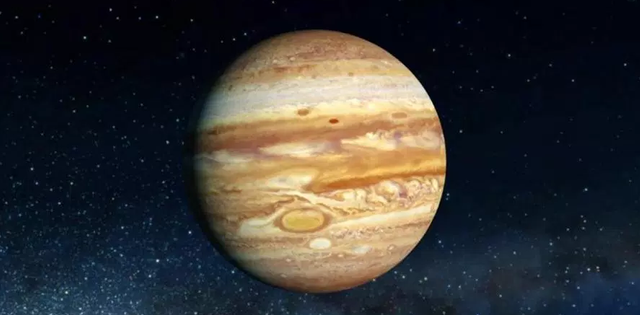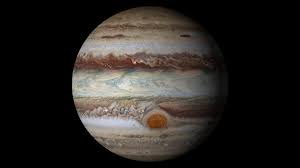Jupiter

Jupiter is the fifth planet in the solar system. It is part of the so-called outer or gaseous planets. It receives its name from the Roman god Jupiter (Zeus in the Greek mythology).
This is the planet that offers a greater brightness throughout the year depending on its phase. It is, in addition, after the sun, the greater celestial body of the solar system, with a mass almost twice and a half of the other planets together (with a mass 318 times greater than that of the earth and three times greater than that of Saturn, besides being , in terms of volume, 1317 times larger than the Earth. It is also the oldest planet in the solar system, being even more ancient than the sun; This discovery was made by researchers from the University of Münster in Germany. 2 3
Jupiter is a massive gaseous body, formed mainly by hydrogen and helium, lacking a defined interior surface. Atmospheric details include the Great Red Spot (a huge anticyclone located in the tropical latitudes of the southern hemisphere), the cloud structure in dark bands and bright areas, and the global atmospheric dynamics determined by intense winds Alternating zones in latitude and with speeds of up to 140 m/s (504 km/h).

Jupiter is the planet with the largest mass of the solar system: it equals about 2.48 times the sum of the masses of all the other planets together. Nevertheless, it is not the most massive planet known: more than a hundred extrasolar planets that have been discovered have masses similar or higher than that of Jupiter. Jupiter also possesses the fastest rotational speed of the planets in the solar system: it rotates in just under ten hours on its axis. This speed of rotation is deduced from the measurements of the planet's magnetic field. The atmosphere is divided into regions with strong zonal winds with rotation periods ranging from 9 h 50 min 30 S, in the equatorial zone, at 9 h 55 min 40 S in the rest of the planet.
The planet is known for a huge meteorological formation, the Great Red Spot, easily visible by amateur astronomers given its large size, superior to the Earth. Its atmosphere is permanently covered with clouds that allow to trace the atmospheric dynamics and show a high degree of turbulence.
Taking as a reference the distance to the Sun, Jupiter is the fifth planet in the solar system. Its orbit is located at approximately 5 UA, about 750 million kilometers from the sun.
Mass [edit]
The mass of Jupiter is such that its baricentro with the sun is actually above its surface (1.068 of solar radio, from the Center of the Sun). Despite being much larger than the Earth (with an eleven times greater diameter), it is considerably less dense. Jupiter's volume is equivalent to 1317 lands, but its mass is only 318 times greater. Jupiter's mass unit (MJ) is used to measure masses of other gaseous planets, especially extrasolar planets and brown dwarfs.
While Jupiter would need to have 80 times its mass to provoke the necessary hydrogen fusion reactions and become a star, the smallest red dwarf known to have only 30% more radio than Jupiter (although it has much more mass). Jupiter radiates more heat than it receives from the scarce sunlight that reaches that distance. The triggered heat difference is generated by the Kelvin-Helmholtz instability by adiabatic contraction (shrinkage). The consequence of this process is the contraction of the planet about two centimeters a year. After its formation, Jupiter was much hotter and had a diameter almost twice the current.
If it were about four times more massive, the interior could become much more compressed because of major gravitational forces, which could lead to a decrease in volume, regardless of whether its mass increased. As a result, it is speculated that Jupiter could reach one of the broadest diameters that a planet of these characteristics and evolution can achieve. The process of reducing the volume with mass increase could continue until a stellar combustion was reached, as in the brown dwarfs with a mass 50 times that of Jupiter. This has led some astronomers to qualify him as a "failed star", although it is not clear whether the processes involved in the formation of planets like Jupiter resemble the processes of creating multiple stellar systems.
Congratulations! This post has been upvoted from the communal account, @minnowsupport, by jonjro from the Minnow Support Project. It's a witness project run by aggroed, ausbitbank, teamsteem, theprophet0, someguy123, neoxian, followbtcnews, and netuoso. The goal is to help Steemit grow by supporting Minnows. Please find us at the Peace, Abundance, and Liberty Network (PALnet) Discord Channel. It's a completely public and open space to all members of the Steemit community who voluntarily choose to be there.
If you would like to delegate to the Minnow Support Project you can do so by clicking on the following links: 50SP, 100SP, 250SP, 500SP, 1000SP, 5000SP.
Be sure to leave at least 50SP undelegated on your account.